![]() Professional short course (111 pages)
Professional short course (111 pages)
Robust methods for assessment of average and scaled average bioequivalence
Professor, University of the Free State, South Africa
Senior Lecturer, University of Pretoria, South Africa
![]() Theoretical considerations (13 pages)
Theoretical considerations (13 pages)
Balaam’s Design Revisited
Chief Scientific Officer, Accelsiors CRO Ltd., Hungary
Director, Biostatistics, Fresenius-Kabi SwissBioSim GmbH, Switzerland
![]() Theoretical considerations (17 pages)
Theoretical considerations (17 pages)
Measuring switchability using observational data
Associate Professor, Semmelweis University, Hungary
![]() Theoretical considerations (31 pages)
Theoretical considerations (31 pages)
Applications of the expected power (statistical assurance) for bioequivalence trials
Head of Biometrics and Statistical Programming, medac GmbH, Germany
![]() Regulatory Questions – Keynote (18 pages)
Regulatory Questions – Keynote (18 pages)
Current challenges in the development of biosimilars
Head of Scientific Unit, Austrian Medicines and Medical Devices Agency, Austria
![]() Regulatory Questions (32 pages)
Regulatory Questions (32 pages)
Quality and statistics: bringing two worlds together
Statistical assessor, Federal Institute for Drugs and Medical Devices (BfArM), Germany
![]() Regulatory Questions (20 pages)
Regulatory Questions (20 pages)
Regulatory reflections on biosimilar development and statistical methods used at quality level
Seconded National Expert from Klinikum rechts der Isar of Technische Universität München to EMA, Germany
![]() Regulatory Questions (18 pages)
Regulatory Questions (18 pages)
Is similarity different? – Recent developments from the regulatory perspective
Biostatistician, Austrian Medicines and Medical Devices Agency (AGES), Austria
![]() 1st PK Course (4-part lecture)
1st PK Course (4-part lecture)
Uni- and multivariate Bioequivalence of PK parameters
Professor of Statistics, Lancaster University, UK
Deputy Director Research Design and Conduct Service and Research Fellow, Cardiff University, UK
![]() 2nd PK Course (3-part lecture)
2nd PK Course (3-part lecture)
Statistical aspects of equivalence testing for biosimilar studies: multiple, differently-scaled endpoints
Professor of Biostatistics at Leibniz Universität Hannover, Faculty of Natural Sciences, Germany
![]() Scientific Keynote
Scientific Keynote
Bioequivalence of highly variable drug products – an update
Professor Emeritus of Pharmacology and Biostatistics, University of Toronto, Canada;
![]() Case Study
Case Study
An update on development strategies of recently approved biosimilars in Europe
Early Stage Research Fellow, IDEAS Innovative Training Network, Germany
![]() Regulatory Keynote
Regulatory Keynote
The biosimilar concept revisited – is there a need for change?
Unit Head, Austrian Medicines and Medical Devices Agency, Austria
![]() Presentation
Presentation
Challenging issues in extrapolation of totality of evidence to pediatric indications in case of biosimilars
Unit Head at National Institute of Pharmacy and Nutrition, Hungary
![]() Case Study
Case Study
Opportunities and limitations of a blinded sample size reassessment in biosimilars development
Head of Biostatistics and Data Management,
Fresenius-Kabi, Switzerland
![]() Case Study
Case Study
Incorporating historical information in biosimilar trials: Challenges and a hybrid Bayesian‐frequentist approach
Early Stage Research Fellow, IDEAS Innovative Training Network, Germany
![]() Case Study
Case Study
How the increase of assay sensitivity influences the immunogenicity
Director Biostatistics for Biostatistics Biosimilars, Analytics group,
Sandoz Biopharmaceuticals, Germany
![]() Case Study
Case Study
Animal models of immunogenicity and immune toxico-equivalence testing of nano-biopharmaceuticals
Director of the Nanomedicine Research and Education Center, Semmelweis Medical University, Hungary
![]() Seminar
Seminar
The immunological characterization of nanotechnology-formulated drugs
Senior Principal Scientist and Head of the Immunology Section at the Nanotechnology Characterization Laboratory, USA
![]() Seminar
Seminar
Targeted Nanomedicine: State of Art and Future Developments
Professor of Targeted Nanomedicine at the University of Utrecht; Professor of Targeted Therapeutics at the MIRA Institute of the University of Twente; The Netherlands
![]() Seminar (2-part lecture)
Seminar (2-part lecture)
The Era of Biosimilars and Nanosimilars: Current Perspectives
President of Bawa Biotech LLC; Adjunct Professor at Rensselaer Polytechnic Institute, USA; Scientific Advisor at Teva Pharmaceutical Industries, Israel; Founding Director of American Society for Nanomedicine; USA
![]() 1st Course
1st Course
Scientific factors in biosimilar product development
Professor Emeritus of Pharmacology and Biostatistics, University of Toronto;
Former President of Canadian Society for Pharmaceutical Scientists, Canada
![]() 2nd Course (3-part lecture)
2nd Course (3-part lecture)
Open issues in the assessment of bioequivalence and biosimilarity
Owner at BEBAC – Consultancy Services for Bioequivalence and Bioavailability Studies, Austria
![]() Regulatory Keynote
Regulatory Keynote
12 years of biosimilars in Europe: what’s the exposure and response in our learning curve?
Andrea LASLOP
Head of Scientific Office, Austrian Medicines and Medical Devices Agency (AGES),
Member of the Scientific Advice Working Party (SAWP) of the European Medicines Agency,
Austria
![]() Keynote
Keynote
Immune side effects of biologicals and nanomedicines: unsolved issues in bio- and nanosimilar development
Director of the Nanomedicine Research and Education Center, Semmelweis Medical University, Professor at University of Miskolc, Dep. of Nanobiotechnology and the Regenerative Medicine, Hungary
![]() Case Study
Case Study
Clinical trials for biosimilars in Europe: an updated systematic comparison of the clinical development programs
Biostatistician,
Novartis Pharma AG,
Germany
![]() Case Study
Case Study
Algorithms for evaluating reference scaled average bioequivalence: power, bias and consumer risk
Associate Professor,
Faculty of Pharmacology, Semmelweis Medical University, Hungary
Co-author: László ENDRÉNYI, Professor Emeritus of Pharmacology and Biostatistics, University of Toronto, Canada
![]() Case Study
Case Study
Regulatory perspective on comparison of quality attributes in drug development
Ina-Christine RONDAK
Biostatistician,
Seconded National Expert from Klinikum rechts der Isar of Technische Universität München to EMA;
Germany
3-part Course: Design and Analysis of Biosimilar Studies
![]() 1st Lecture (67 slides)
1st Lecture (67 slides)
Assessing Biosimilarity: Issues and Recent Development
![]() 2nd Lecture (62 slides)
2nd Lecture (62 slides)
Assessing Interchangeability: Issues, Designs and Statistical Methods
![]() 3rd Lecture (65 slides)
3rd Lecture (65 slides)
Analytical Similarity Assessment in Biosimilar Studies
Instructor: Shein-Chung CHOW
– Professor, Biostatistics and Bioinformatics, Duke University School of Medicine;
– Special Government Employee and statistical consultant of the US FDA;
– Author or co-author of over 280 methodology papers and 24 books including Biosimilars: Design and Analysis of Follow-on Biologics; USA
CONFERENCE REPORT ARTICLES ABOUT THE PREVIOUS FORUMS
- 4th Annual Biosimilars Forum – Conference Report Article
-

 17 – 18 OCTOBER, 2019
17 – 18 OCTOBER, 2019  Budapest, Hungary
Budapest, HungaryINTERLOCKING TRADITIONS AND NEW IDEAS IN THE DISCUSSIONS ON BIOSIMILAR DEVELOPMENT AT ACCELSIORS LTD.
Three years ago, in January 2016, when the idea of such a forum first popped up in a personal discussion (between the president of the Viennese Section of the International Biometric Society at that time and the president of the Hungarian Society for Clinical Biostatistics) noone thought that a long-standing tradition just started, and one could not predict how long this series of events will survive.
Excerpt from the first announcement in 2016: “This two-day event is targeted to clinical research professionals working in the area of biosimilars. Topics will include current issues and challenges confronting researchers in this important field. The objective is to provide participants with an environment to engage in open and constructive dialogue with like colleagues to facilitate collaboration”.
The keyword in this text is the “environment”. Maybe it was indeed the sincere and friendly atmosphere which made this event so special (distinguishing it from the many other similar conferences) from the very beginning. New topics were brought up each year, and now, at the end of the fourth Biosimilars Forum the organizers can be optimistic about the future, the glass is already half full, that is some of the next year programs were already fixed.
Organizers
This year the structure was similar to previous forums: a short course on the first day, followed by presentations and discussions on the second day.
 Robert Schall’s and Divan Burger’s lecture on robust methods for the assessment of average and scaled average bioequivalence presented an interesting new solution for addressing the violation of ANOVA assumptions. The classical topic of situations when the normality condition does not hold was studied by many authors but the known options are not very convincing, and some of them are even incorrect (like pre-testing the assumptions, and basing the choice between tests on the result of a test for normality). The authors of the short course proposed a new method in which t-distributed residual errors are assumed. The t-distribution proved to be flexible enough to handle skewed and heavy-tailed distributions (including outliers) in a unified framework.
Robert Schall’s and Divan Burger’s lecture on robust methods for the assessment of average and scaled average bioequivalence presented an interesting new solution for addressing the violation of ANOVA assumptions. The classical topic of situations when the normality condition does not hold was studied by many authors but the known options are not very convincing, and some of them are even incorrect (like pre-testing the assumptions, and basing the choice between tests on the result of a test for normality). The authors of the short course proposed a new method in which t-distributed residual errors are assumed. The t-distribution proved to be flexible enough to handle skewed and heavy-tailed distributions (including outliers) in a unified framework. Following the thought-provoking short course some other methodological issues were addressed next day. One of them was Balaam’s design which was not very popular in the past (perhaps due to its inefficiency in terms of sample size) but nowadays it is recommended for interchangeability studies. Júlia Singer presented a summary of apparently different models applied which often lead to the same result, pointing out that inefficiency continues to be a drawback of this design.
Following the thought-provoking short course some other methodological issues were addressed next day. One of them was Balaam’s design which was not very popular in the past (perhaps due to its inefficiency in terms of sample size) but nowadays it is recommended for interchangeability studies. Júlia Singer presented a summary of apparently different models applied which often lead to the same result, pointing out that inefficiency continues to be a drawback of this design. Switchability of biosimilars continues to be a controversial topic because the relevance and sensitivity of the proposed PK/PD approach was often questioned. László Tóthfalusi raised the possibility of characterizing switchability using long-term observational data. This type of analysis is closer to real life, and the need of switching occurs in a natural way (whereas in clinical studies switches occur after pre-defined periods). Time to need of switch (for which multiple reasons like decreasing efficiency, side effects etc. can be identified) is the primary endpoint in such observational studies. The results presented at the conference were convincing and informative. The hazard of treatment failure for a certain product is a clinically meaningful and sensitive parameter, enabling also the comparison of more biosimilars of a same originator, and also the analysis of risk factors (co-treatment, gender) from a relatively small clinical database. The variables necessary for this analysis can be obtained from health-insurance databases.
Switchability of biosimilars continues to be a controversial topic because the relevance and sensitivity of the proposed PK/PD approach was often questioned. László Tóthfalusi raised the possibility of characterizing switchability using long-term observational data. This type of analysis is closer to real life, and the need of switching occurs in a natural way (whereas in clinical studies switches occur after pre-defined periods). Time to need of switch (for which multiple reasons like decreasing efficiency, side effects etc. can be identified) is the primary endpoint in such observational studies. The results presented at the conference were convincing and informative. The hazard of treatment failure for a certain product is a clinically meaningful and sensitive parameter, enabling also the comparison of more biosimilars of a same originator, and also the analysis of risk factors (co-treatment, gender) from a relatively small clinical database. The variables necessary for this analysis can be obtained from health-insurance databases.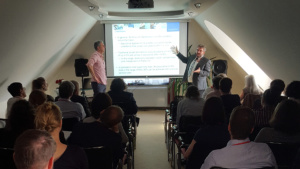 During the sample size evaluation of clinical studies in biosimilar development programs (like phase 1 equivalence of PK parameters, and phase 3 therapeutic equivalence) sample sizes are often underestimated due to the assumption of completely identical distributions for the originator and the biosimilar product. Alternatively, some sponsors routinely assume a small difference between means (like a typical ratio of 1.05 for the geometric means of PK parameters). Arne Ring presented a review of these approaches and proposed a more structured way of handling small differences between distributions by introducing the concept of assurance (expected power). The method is taking into account the uncertainty in the assumptions of sample size assessment, and usually leads to feasible sample sizes.
During the sample size evaluation of clinical studies in biosimilar development programs (like phase 1 equivalence of PK parameters, and phase 3 therapeutic equivalence) sample sizes are often underestimated due to the assumption of completely identical distributions for the originator and the biosimilar product. Alternatively, some sponsors routinely assume a small difference between means (like a typical ratio of 1.05 for the geometric means of PK parameters). Arne Ring presented a review of these approaches and proposed a more structured way of handling small differences between distributions by introducing the concept of assurance (expected power). The method is taking into account the uncertainty in the assumptions of sample size assessment, and usually leads to feasible sample sizes.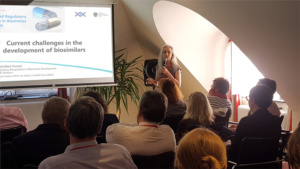 Maybe the most expected session was the one in which regulators talked about challenges in biosimilar development. The keynote presentation was held by Andrea Laslop, starting with an overall picture of biosimilars in Europe: 61 products registered (out of which 7 were already withdrawn), corresponding to 15 originators. One of the differences between the regulation in EU compared to other regions is the decreasing role of in vivo studies, shifting the emphasis more and more to the quality attributes, and towards a deeper understanding of the relationship between quality attributes and clinical outcome. All this can be summarized in the principle of 3Rs, meaning: Replace, Reduce, Refine.
Maybe the most expected session was the one in which regulators talked about challenges in biosimilar development. The keynote presentation was held by Andrea Laslop, starting with an overall picture of biosimilars in Europe: 61 products registered (out of which 7 were already withdrawn), corresponding to 15 originators. One of the differences between the regulation in EU compared to other regions is the decreasing role of in vivo studies, shifting the emphasis more and more to the quality attributes, and towards a deeper understanding of the relationship between quality attributes and clinical outcome. All this can be summarized in the principle of 3Rs, meaning: Replace, Reduce, Refine. Ina-Christine Rondak presented reflections on statistical aspects at quality level (CHMP. Draft Reflection paper on statistical methodology for the comparative assessment of quality attributes in drug development. 2017) After a short historical overview the comments received on the draft Reflection Paper were summarized. These comments were summarized and discussed extensively last year during a 5-day workshop (CHMP. Meeting Report: Workshop on the draft reflection paper on statistical methodology for the comparative assessment of quality attributes in drug development. 2018) where 31 representants of different pharma industry associtations, 31 EU regulators from 21 national competent authorities (+1 FDA representant) exchanged ideas. Some of the commenters pointed out that statistical decision should not be limited to a pass/fail criterion. Some of the other questions and concerns raised by commenters: the scope of reflection paper is too broad, more specific reflections dependent on the setting would be needed. The reflection paper uses the term similarity but it does not give an exact definition. There might be an inherent contradiction between „consistent manufacturing“ and shift/drifts in means.
Ina-Christine Rondak presented reflections on statistical aspects at quality level (CHMP. Draft Reflection paper on statistical methodology for the comparative assessment of quality attributes in drug development. 2017) After a short historical overview the comments received on the draft Reflection Paper were summarized. These comments were summarized and discussed extensively last year during a 5-day workshop (CHMP. Meeting Report: Workshop on the draft reflection paper on statistical methodology for the comparative assessment of quality attributes in drug development. 2018) where 31 representants of different pharma industry associtations, 31 EU regulators from 21 national competent authorities (+1 FDA representant) exchanged ideas. Some of the commenters pointed out that statistical decision should not be limited to a pass/fail criterion. Some of the other questions and concerns raised by commenters: the scope of reflection paper is too broad, more specific reflections dependent on the setting would be needed. The reflection paper uses the term similarity but it does not give an exact definition. There might be an inherent contradiction between „consistent manufacturing“ and shift/drifts in means. Andreas Brandt continued these thoughts by analysing the questions and concerns from statistical point of view, pointing out that similarity can’t be identified with equivalence in mean, but with equivalence in distribution. And the main distinction between descriptive and inferential statistics does not consist in different methodologies but in the conclusions drawn from the results (valid only for the observed batches or extrapolating for other batches as well).
Andreas Brandt continued these thoughts by analysing the questions and concerns from statistical point of view, pointing out that similarity can’t be identified with equivalence in mean, but with equivalence in distribution. And the main distinction between descriptive and inferential statistics does not consist in different methodologies but in the conclusions drawn from the results (valid only for the observed batches or extrapolating for other batches as well). Stephan Lehr’s interactive presentation (during which – like in a quiz – the audience had to guess and recognize some quotations from different guidelines) formulated some challenging questions preparing in a way also the next session. Stimulating thoughts were grouped around 4 topics:
Stephan Lehr’s interactive presentation (during which – like in a quiz – the audience had to guess and recognize some quotations from different guidelines) formulated some challenging questions preparing in a way also the next session. Stimulating thoughts were grouped around 4 topics:- Revision of „products containing recombinant granulocyte-colony stimulating factor”
- Guideline on estimand in clinical equivalence trials (Appendix to ICH E9)
- Bayesian approaches to demonstrate biosimilarity
- Development in rare diseases
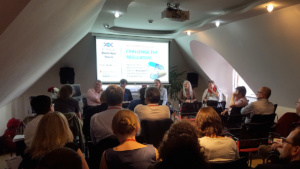 This session was followed by a regulatory panel discussion and Q&A type of interaction in which replies were given to critical questions from the audience with a focus on the current regulatory requirements, approval process and burning issues of debate facing clinical development teams specialized on biosimilars.
This session was followed by a regulatory panel discussion and Q&A type of interaction in which replies were given to critical questions from the audience with a focus on the current regulatory requirements, approval process and burning issues of debate facing clinical development teams specialized on biosimilars.It seemed that the main challenge for companies developing biosimilars was still the “moving target” phenomenon, i.e. the fact that the originator also has its own life cycle in which changes in the manufacturing process may occur. Some of the questions referred to the new terminology defined in the appendix of the old statistical guideline (ICH E9 (R1) addendum on estimands and sensitivity analysis in clinical trials to the guideline on statistical principles for clinical trials) which is expected to become effective in the near future, with some changes compared to the draft version (due to the large number of comments received to the draft version).
Discussions were open, colloquial, thought-provoking, and could be continued „till cows come home”, but had to be censored once. However, the participants were confident that they will meet next year at the 5th forum.
- 3rd Annual Biosimilars Forum – Conference Report Article
-

 25 – 27 OCTOBER, 2018
25 – 27 OCTOBER, 2018  Budapest, Hungary
Budapest, HungaryBiosimilars & Nanosimilars: Chalenges and Future Perspectives – note from Annual Professional Forum at Accelsiors Ltd, Budapest
Overview: As a third in a series of events, this mini conference called Biosimilar Forum has already traditions. And because traditions are good to be kept, this year the same structure was followed as before: short course, invited speakers, presentations, round table. What was new this year was a third day which was entirely dedicated to nanosimilars. The three-day forum comprised 8 plenary sessions, with in total 16 speakers from around the world.
Day 1: PK short courses
Organizers
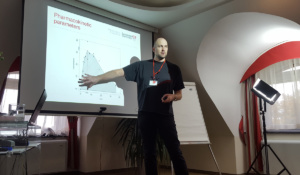 There were two short courses, both focusing on the problem of multiplicity in PK equivalence studies of biosimilars. Both pointing out that although there is a detailed guideline available for the univariate handling of PK parameters, the questions of multiplicity and the handling of missing data (mainly data below the limit of quantification) are still open. Solutions are complicated and a good guideline avoiding the cookbook style would be needed, but this may take years. When it arrived to real examples it was really interesting to see that the two different theoretical solutions proposed, based on different principles (Thomas Jaki’s and Philip Pallmann’s method based on joint confidence regions [for which an R package jocre was developed by Philip Pallmann], and Ludwig Hothorn’s method of a union-intersection test [UIT]) approach [more precisely UIT for testing multiple endpoints and multiple treatments, and intersection-union test for the two one-sided tests applied to each single parameter]) led to very similar results at the end.
There were two short courses, both focusing on the problem of multiplicity in PK equivalence studies of biosimilars. Both pointing out that although there is a detailed guideline available for the univariate handling of PK parameters, the questions of multiplicity and the handling of missing data (mainly data below the limit of quantification) are still open. Solutions are complicated and a good guideline avoiding the cookbook style would be needed, but this may take years. When it arrived to real examples it was really interesting to see that the two different theoretical solutions proposed, based on different principles (Thomas Jaki’s and Philip Pallmann’s method based on joint confidence regions [for which an R package jocre was developed by Philip Pallmann], and Ludwig Hothorn’s method of a union-intersection test [UIT]) approach [more precisely UIT for testing multiple endpoints and multiple treatments, and intersection-union test for the two one-sided tests applied to each single parameter]) led to very similar results at the end.Day 2: Symposium – Clinical studies and regulatory questions
On the next day various problems related to biosimilar development were discussed. We got update on the bioequivalence of highly variable drugs (László Endrényi), and on development strategies of recently approved biosimilars in Europe (Johanna Mielke).
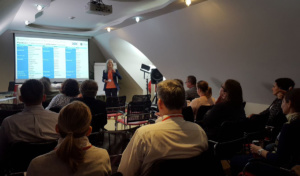 The regulatory keynote presentation was held by Andrea Laslop, and she gave some very interesting examples of difficult decision when the prescriptions of the guideline could not be kept entirely (e.g. confidence interval slightly exceeding the pre-defined margins which could be attributed to recent manufacturing changes of the originator, or slightly higher ADA incidence which did not translate into meaningful differences in clinical efficacy) but still a positive decision was made based on the totality of evidence. All these lead to the conclusion that the assessment of biosimilarity in critical quality attributes should be strengthened in the future (new statistical approaches to be defined), and tailoring of clinical evidence is needed. Gyurasics Ágnes presented some challenging issues in extrapolation of totality of evidence to pediatric indications in case of biosimilars.
The regulatory keynote presentation was held by Andrea Laslop, and she gave some very interesting examples of difficult decision when the prescriptions of the guideline could not be kept entirely (e.g. confidence interval slightly exceeding the pre-defined margins which could be attributed to recent manufacturing changes of the originator, or slightly higher ADA incidence which did not translate into meaningful differences in clinical efficacy) but still a positive decision was made based on the totality of evidence. All these lead to the conclusion that the assessment of biosimilarity in critical quality attributes should be strengthened in the future (new statistical approaches to be defined), and tailoring of clinical evidence is needed. Gyurasics Ágnes presented some challenging issues in extrapolation of totality of evidence to pediatric indications in case of biosimilars. Continuing with a problem similar to the question raised by Andrea Laslop (i.e. how to take into account changes in the manufacturing changes of the originator), Heike Woehling analyzed cases where differences between immunogenicity results were partly attributable to the increased assay sensitivity. Common statistical tests do not take into account changes occurred in assay methodology, therefore estimates of the same parameter obtained at different time points are difficult to be compared. However, as Julia Singer pointed out, statistical methods to adjust the observed proportions for a known sensitivity and specificity are known (the first such method was published by Rogan and Gladen, 1978).
Continuing with a problem similar to the question raised by Andrea Laslop (i.e. how to take into account changes in the manufacturing changes of the originator), Heike Woehling analyzed cases where differences between immunogenicity results were partly attributable to the increased assay sensitivity. Common statistical tests do not take into account changes occurred in assay methodology, therefore estimates of the same parameter obtained at different time points are difficult to be compared. However, as Julia Singer pointed out, statistical methods to adjust the observed proportions for a known sensitivity and specificity are known (the first such method was published by Rogan and Gladen, 1978).Although in different ways, all the presentations addressed somehow the question of what the future may/might bring to us. For instance, Johanna Mielke presented a hybrid Bayesian-frequentist statistical method to incorporate historical information on the reference product in clinical studies to assess biosimilarity. Emmanuelle Vincent shared her experience about the opportunities and limitations of a blinded sample size reassessment in some clinical studies. In the future the role of PD markers is expected to increase, and skipping clinical efficacy trials in the development of biosimilars will be chosen more and more often.
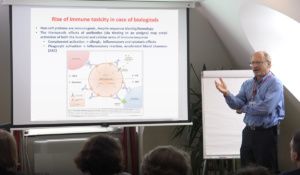 As a kind of preambulum to the third day of the forum which was dedicated to nanosimilars, János Szebeni delivered a presentation on animal models of immunogenicity and immune toxico-equivalence testing of nano-biopharmaceuticals.
As a kind of preambulum to the third day of the forum which was dedicated to nanosimilars, János Szebeni delivered a presentation on animal models of immunogenicity and immune toxico-equivalence testing of nano-biopharmaceuticals.In the closing part of the second day there was an animated panel discussion led by Helmut Schuetz. Various topics were raised, here we mention only some of them: the inadequacy of the simple two-by-two cross-over design to separate different effects like period, sequence, carry-over; the criterion of equivalence in mean is required which later might be incorrectly interpreted as equivalence in distribution.
Day 3: Seminars in nanosimilars
As a very interesting novelty in this year’s programme, the 3rd-day agenda consisted of professional Seminar sessions dedicated to the nanodrug development topic with the participation of invited expert lecturers from the field of nanotechnology-formulated drug research.
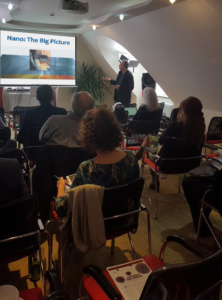 In the morning session, Raj Bawa (Founding Director of American Society for Nanomedicine) delivered a 2-part seminar about the current perspectives in the era of biosimilars and nanosimilars. He gave a thorough overview of this topic, touching the current challenges in drug R&D in the fields of biologics, nanomedicine, bio- and nanosimilars, pointing out the technological as well as the market trends and business aspects, covering the topics of the evolving regulations, patenting and future development opportunities. Translational challenge in medicine at nanoscale has been presented, as well as the whole translation process including all steps from basic research toward drug registration. Basics related to biological products has been described, including but not limited to explanations of their complexity level along with numerous examples from practice. Finally, Dr. Bawa gave a detailed description on nanotechnology and a detailed overview for the fields of targeted nanomedicine, bio- and nanosimilar drug development. Specifically related to this topic – different material types, route of administration, as well as various factors influencing safety and efficiency of the nanodrugs were extensively discussed.
In the morning session, Raj Bawa (Founding Director of American Society for Nanomedicine) delivered a 2-part seminar about the current perspectives in the era of biosimilars and nanosimilars. He gave a thorough overview of this topic, touching the current challenges in drug R&D in the fields of biologics, nanomedicine, bio- and nanosimilars, pointing out the technological as well as the market trends and business aspects, covering the topics of the evolving regulations, patenting and future development opportunities. Translational challenge in medicine at nanoscale has been presented, as well as the whole translation process including all steps from basic research toward drug registration. Basics related to biological products has been described, including but not limited to explanations of their complexity level along with numerous examples from practice. Finally, Dr. Bawa gave a detailed description on nanotechnology and a detailed overview for the fields of targeted nanomedicine, bio- and nanosimilar drug development. Specifically related to this topic – different material types, route of administration, as well as various factors influencing safety and efficiency of the nanodrugs were extensively discussed.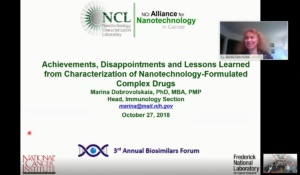 In the following session of the forum, Marina Dobrovolskaia (Head of the Immunology Section at the Nanotechnology Characterization Laboratory) showcased her online presentation about the immunological characterization of nanotechnology-formulated drugs and she gave deep insight into the achievements, disappointments and lessons learned over past decade from the developments in the area of this highly complex drugs. During the presentation Dr. Dobrovolskaia pointed out the importance of endotoxin screening for preventing erroneous data and corresponding wrong conclusions. Potential problems with immunogenicity of protein based APIs or targeting ligands due to the endotoxin presence were commented. Challenges related to the translation of therapeutic nucleic acids from bench to bedside were raised, including the importance of immune-mediated toxicities causing product development discontinuation. The importance of understanding mechanism of toxicity for the creation of safe and efficient complex drug systems was also discussed during this session.
In the following session of the forum, Marina Dobrovolskaia (Head of the Immunology Section at the Nanotechnology Characterization Laboratory) showcased her online presentation about the immunological characterization of nanotechnology-formulated drugs and she gave deep insight into the achievements, disappointments and lessons learned over past decade from the developments in the area of this highly complex drugs. During the presentation Dr. Dobrovolskaia pointed out the importance of endotoxin screening for preventing erroneous data and corresponding wrong conclusions. Potential problems with immunogenicity of protein based APIs or targeting ligands due to the endotoxin presence were commented. Challenges related to the translation of therapeutic nucleic acids from bench to bedside were raised, including the importance of immune-mediated toxicities causing product development discontinuation. The importance of understanding mechanism of toxicity for the creation of safe and efficient complex drug systems was also discussed during this session. The nanomedicine part of the event was further strengthened by Gert Storm, who presented an interesting overview about the current status and future opportunities in the use of nanoparticles for drug targeting. Opportunities to achieve increased therapeutic index through targeted nanomedicines able to favourably change the efficacy/safety balance were discussed. Prof Storm shared his experience related to major limitation of IV nanoparticulate drug targeting has been presented in dynamic and comprehensive way. Special attention has been draw on extravasation through ‘leaky’ vasculature – EPR effect which can, by improving accessibility, positively affect drug efficacy. The use of EPR passive drug targeting to tumor was also presented through practical examples.
The nanomedicine part of the event was further strengthened by Gert Storm, who presented an interesting overview about the current status and future opportunities in the use of nanoparticles for drug targeting. Opportunities to achieve increased therapeutic index through targeted nanomedicines able to favourably change the efficacy/safety balance were discussed. Prof Storm shared his experience related to major limitation of IV nanoparticulate drug targeting has been presented in dynamic and comprehensive way. Special attention has been draw on extravasation through ‘leaky’ vasculature – EPR effect which can, by improving accessibility, positively affect drug efficacy. The use of EPR passive drug targeting to tumor was also presented through practical examples.In the final discussion section of the conference, the participants had a highly constructive conversation about the future perspectives of bio- and nanosimilars, recent developments, as well as regulatory challenges in the field of innovative drug development.
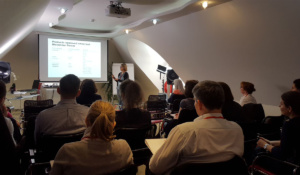 The audience of the Forum comprised various professions like regulators, medical scientists, clinical researchers, experienced biostatisticians and other representatives of the pharmaceutical developer companies. The size (around 100 participants in total) and the cozy atmosphere of this event enables not only rigorous methodological presentations but also sincere and friendly discussions as well as professional networking. All the participants agreed that – like the previous two forums hosted by Accelsiors – this was a very fruitful meeting, helping to share problems, to crystallize ideas, and it might contribute to the development of new guidelines and changing the old ones if needed.
The audience of the Forum comprised various professions like regulators, medical scientists, clinical researchers, experienced biostatisticians and other representatives of the pharmaceutical developer companies. The size (around 100 participants in total) and the cozy atmosphere of this event enables not only rigorous methodological presentations but also sincere and friendly discussions as well as professional networking. All the participants agreed that – like the previous two forums hosted by Accelsiors – this was a very fruitful meeting, helping to share problems, to crystallize ideas, and it might contribute to the development of new guidelines and changing the old ones if needed. - 2nd Annual Biosimilars Forum – Conference Report Article
-

 5 – 6 OCTOBER, 2017
5 – 6 OCTOBER, 2017  Budapest, Hungary
Budapest, HungaryAccount of experiences about the 2nd Annual Biosimilars Forum
World’s prominent biosimilar development experts have returned to Budapest to the 2nd Annual Biosimilars Forum on 5 – 6 October, 2017.
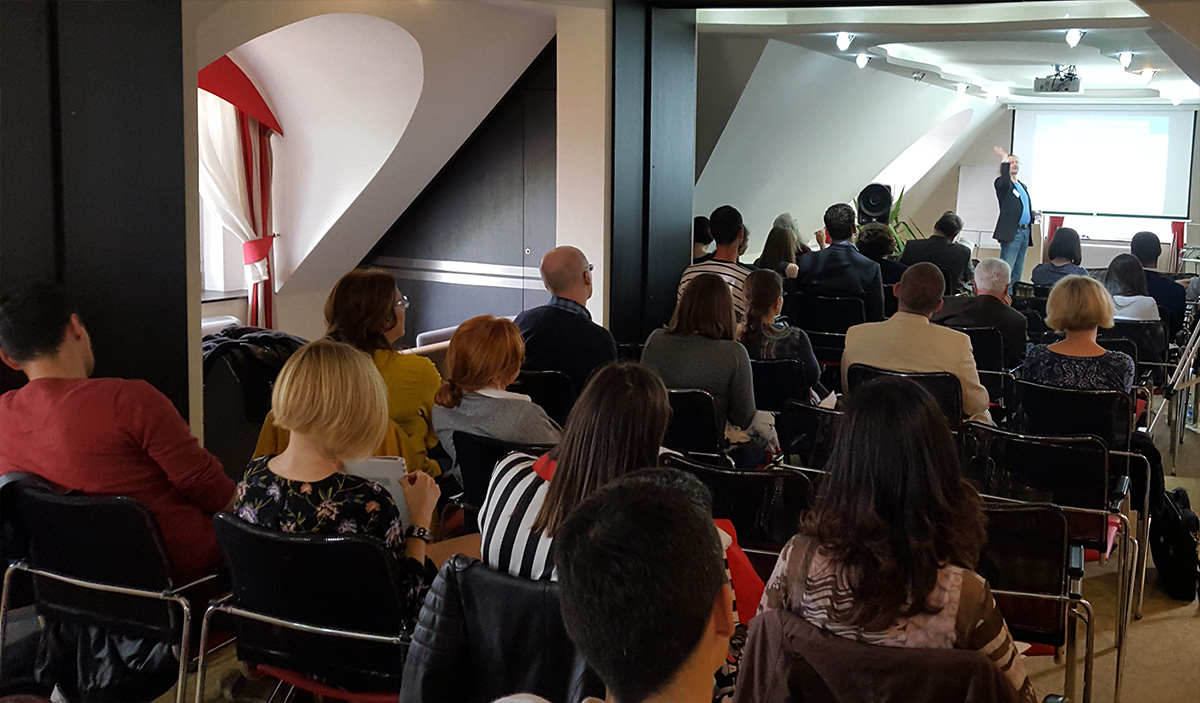 Accelsiors CRO has partnered with the Viennese Section of the International Biometric Society and the Hungarian Society for Clinical Biostatistics once again to deliver this unique professional forum for research management, leadership and support teams working in and for biosimilar drug development.
Accelsiors CRO has partnered with the Viennese Section of the International Biometric Society and the Hungarian Society for Clinical Biostatistics once again to deliver this unique professional forum for research management, leadership and support teams working in and for biosimilar drug development.The professionally very fruitful 2nd Biosimilars Forum was hosted in Budapest, 5 – 6 October, 2017 by Accelsiors CRO with participation of internationally renowned experts of biosimilar drug development such as Prof. Dr. László Endrényi (Professor Emeritus of University of Toronto), Andrea Laslop (Head of Scientific Office, Austrian Medicines and Medical Devices Agency), Helmut Schütz (Owner at BEBAC – Consultancy Services), and clinical researchers, biostatisticians, regulatory professionals and sponsors from around the world.
This year’s two-day forum covered important issues and specific areas of debate facing clinical development teams specialized on biosimilars. The program of the event was very comprehensive and integrated multiple perspectives on current biosimilar research.
Focused on statistical and regulatory perspectives of biosimilar development
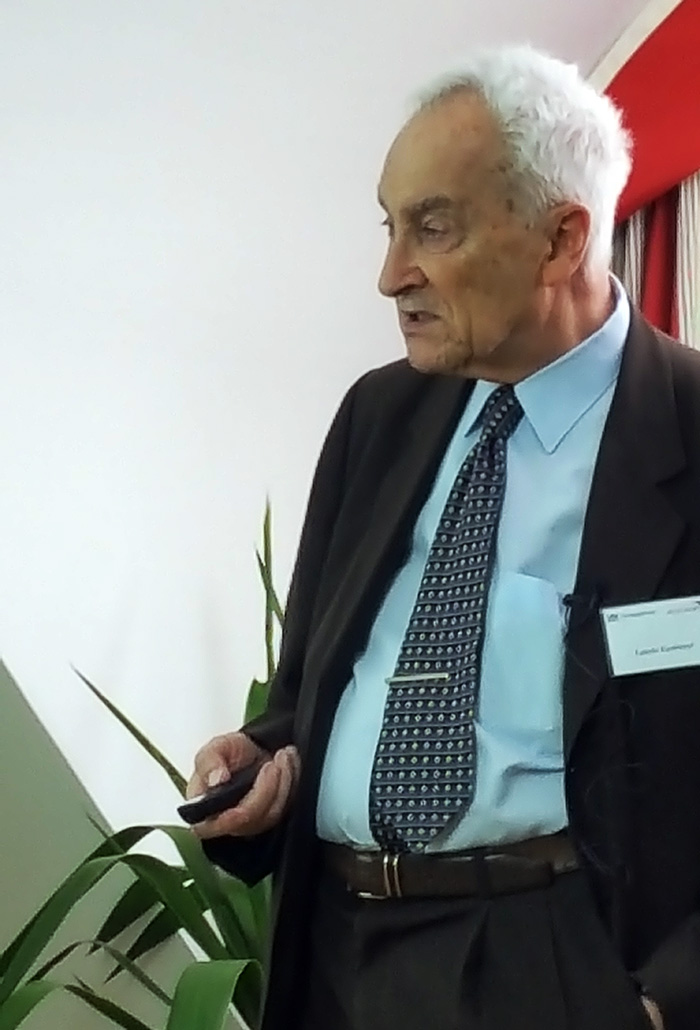 The 2nd Annual Biosimilars Forum welcomed László Endrényi Professor Emeritus from the University of Toronto who presented a lecture about Scientific factors in biosimilar product development. A very substantial course was delivered by Helmut Schütz, owner at BEBAC – Consultancy Services, who gave a detailed overview about open issues in the assessment of bioequivalence and biosimilarity.
The 2nd Annual Biosimilars Forum welcomed László Endrényi Professor Emeritus from the University of Toronto who presented a lecture about Scientific factors in biosimilar product development. A very substantial course was delivered by Helmut Schütz, owner at BEBAC – Consultancy Services, who gave a detailed overview about open issues in the assessment of bioequivalence and biosimilarity.The EMA regulatory expert Andrea Laslop showcased her keynote presentation about the 12 years of biosimilars in Europe and provided an essential understanding of the European regulatory framework. The regulatory part of the forum was further strengthened by Ina-Christine Rondak’s lecture (Seconded National Expert from Technische Universität München to EMA), she presented a useful overview of regulatory perspective on comparison of quality attributes in drug development.
As a very interesting novelty in this year’s program Prof. Janos Szebeni, Director of the Nanomedicine Research and Education Center delivered a keynote presentation about the immune side effects and unsolved issues in bio- and nanosimilar development.
The program of the event gave deep insight into the statistical perspective of biosimilar research. The prominent lecturers such as László Tóthfalusi (Associate Professor of Semmelweis Medical University), Bernd Jilma (Vice Chair, Department Clinical Pharmacology, Medical University of Vienna) and Johanna Mielke (Biostatistician at Novartis Pharma AG) provided an overview about scientific principles and methodologies used in the design and analysis of biosimilar studies as well as their recent industry experiences.
 The members of the round table section from industry, regulatory and academic site had a really fruitful and constructive discussion both on actual challenges and open issues of biosimilar development. The participants of this open discussion such as Stephan Lehr (Biostatistician, Austrian Medicines and Medical Devices Agency and President of Viennese Section of IBS), Heike Wöhling (Head of Biostatistics, Sandoz Biopharmaceuticals), Ildikó ARADI (Head of Clinical Development of Biologics, Gedeon Richter Plc., Vice-Chair, European Generic medicines Association – European Biosimilars Group), Franz KÖNIG (Associate Professor at Medical Unversity of Vienna, Section for Medical Statistics), Vid STANULOVIC (Consultant, Clinical Development and Pharmacovigilance) had a highly constructive conversation about regulatory and industry perspectives of biosimilars, recent developments, as well as about essential statistical methods and high-level research.
The members of the round table section from industry, regulatory and academic site had a really fruitful and constructive discussion both on actual challenges and open issues of biosimilar development. The participants of this open discussion such as Stephan Lehr (Biostatistician, Austrian Medicines and Medical Devices Agency and President of Viennese Section of IBS), Heike Wöhling (Head of Biostatistics, Sandoz Biopharmaceuticals), Ildikó ARADI (Head of Clinical Development of Biologics, Gedeon Richter Plc., Vice-Chair, European Generic medicines Association – European Biosimilars Group), Franz KÖNIG (Associate Professor at Medical Unversity of Vienna, Section for Medical Statistics), Vid STANULOVIC (Consultant, Clinical Development and Pharmacovigilance) had a highly constructive conversation about regulatory and industry perspectives of biosimilars, recent developments, as well as about essential statistical methods and high-level research.The organizers are delighted that they could establish an opportunity with this event series for a constructive and open dialogue between medical statisticians, regulatory professionals, clinical researchers and sponsors with whom they collaborate and many interested people visited the event to learn and network. Visitors could take part in the experience with some of the world’s most prominent experts of this innovative field who gave a detailed overview in biosimilar product development and gave a guidance how to adjust clinical research practice to effective legislation or vice versa, raised ideas on how legislation could be developed further to meet the challenges this quickly developing field pose.
The organizers of the 2nd Annual Biosimilars Forum are proud that they once more had the chance to support biosimilar development professionals and they have assisted in sharing of recent scientific and practical knowledge aimed at increasing effectiveness of drug research.
- 1st Annual Biosimilars Forum – Conference Report Article
-

 OCTOBER, 2016
OCTOBER, 2016  Budapest, Hungary
Budapest, HungaryAccount of experiences about the 1st Annual Biosimilars Forum

The very successful 1st Annual Biosimilars Forum was hosted in Budapest on October of the last year by Acclesiors CRO with participation of international scientific experts such as Shein-Chung Chow (Professor of Duke University School of Medicine), Prof Dr. László Endrényi (Professor Emeritus of University of Toronto), and clinicians, statisticians and regulatory representatives gathered together from around the world to share with each other their perspectives on this hot topic of research in lectures and informal discussions.
Shein-Chung Chow (Professor, Department of Biostatistics and Bioinformatics, Duke University School of Medicine; Special Government Employee and statistical consultant of the US FDA; Editor-in-Chief of three journals including the Journal of Biopharmaceutical Statistics, Drug Designing, and the Journal of Biosimilars), invited guest lecturer gave a thorough overview of the topic on the first day, touching the design and analysis of biosimilar studies, providing an overview of current FDA regulatory requirements for assessing biosimilarity of biosimilar products and giving a detailed description of the fundamental differences and assumptions between the chemical generic products and follow-on biologics. ”I think the development of biosimilars is heading for a great future” – he pointed out, illustrated by the increase in spending and sales in the industry and giving some insight into the history and current situation of submissions in the field. Johanna Mielke (Biostatistician, Novartis Pharma AG) provided a bigger picture through a systematic review of authorised biosimilars in the European Union. ”Biosimilars are essentially cheaper than the original drugs” – said Prof. Dr. László Endrényi (Professor Emeritus, University of Toronto; Former President of Canadian Society for Pharmaceutical Scientists), key lecturer of the event, thus it is not only a business opportunity for developers to put them on the market, they also foster having sustainable health care systems and are ultimately of the interest of patients.
However, as biosimilars emerge as a rapidly growing segment, there are challenges to overcome and questions to answer. Challenges begin with manufacturing: as compared to small-molecule generic products, in the case of biosimilars ”it is much more difficult to imitate the original product” – continues Prof. Dr. László Endrényi, which in fact has an effect on sale prices: ”Whereas a generic product can be 50-70% cheaper than the brand name drug, in the case of biosimilars the difference would be perhaps 20-30%. But that is still a lot, because biological drugs are very-very expensive”. The speciality of manufacturing biosimilars is also reflected in the fact that „right now there is a major concern that the EU and US licenced reference products are not really similar in some cases”, adds Shein-Chung Chow, which can undermine intentions to prove biosimilarity of a drug simultaneously to both references.
 This latter issue raises the question of harmonization between regulatory requirements of the EMA, FDA and beyond, however it appears that there is room to improve on currently existing non-global legislation as well. Commenting on the currently existing EMA guidelines, Ildikó Aradi, Head of Clinical Development of Biologics at Gedeon Richter Plc. noted that ”the European Agency has a pioneering role in biosimilar development and they are taking some next steps”, as several further guidances are under development, further commenting that „the guidances that we have now are good and they are flexible”. This implies that „there is still some lack in some areas where there could be more guidance”, as Stephan Lehr (Biostatistician, Austrian Medicines and Medical Devices Agency) adds. Prof. Dr. László Endrényi had some concerns regarding the United States legislation and beginned with a comparison: „ The pathways are very-very different in the European Union and the United States. In Europe they go almost product by product and there are some guidelines for each product class. In the United States they try to have a big encompassing legislation which covers everything – and it cannot.” In his lecture, he pointed out that having limited authority, central regulators (EMA and US) do not always take responsibility over issues, such is the case with interchangeability which leads to de-centralised solutions. There was a consensus amongst participants of the event that globally harmonized guidelines would be desirable and events attaining international attention like this are bringing us closer to achieving it.
This latter issue raises the question of harmonization between regulatory requirements of the EMA, FDA and beyond, however it appears that there is room to improve on currently existing non-global legislation as well. Commenting on the currently existing EMA guidelines, Ildikó Aradi, Head of Clinical Development of Biologics at Gedeon Richter Plc. noted that ”the European Agency has a pioneering role in biosimilar development and they are taking some next steps”, as several further guidances are under development, further commenting that „the guidances that we have now are good and they are flexible”. This implies that „there is still some lack in some areas where there could be more guidance”, as Stephan Lehr (Biostatistician, Austrian Medicines and Medical Devices Agency) adds. Prof. Dr. László Endrényi had some concerns regarding the United States legislation and beginned with a comparison: „ The pathways are very-very different in the European Union and the United States. In Europe they go almost product by product and there are some guidelines for each product class. In the United States they try to have a big encompassing legislation which covers everything – and it cannot.” In his lecture, he pointed out that having limited authority, central regulators (EMA and US) do not always take responsibility over issues, such is the case with interchangeability which leads to de-centralised solutions. There was a consensus amongst participants of the event that globally harmonized guidelines would be desirable and events attaining international attention like this are bringing us closer to achieving it. Stephan Lehr touched in his presentation methodological issues discussed with authorities in the planning stage and gave some insights into assessment from a regulatory point of view. Andrea Laslop (Unit Head, Austrian Medicines and Medical Devices Agency) gave a presentation about the concept of ’totality of evidence’ adjusted for biosimilars, and discussed how to avoid pitfalls in the step-wise approach at the quality, non-clinical and clinical levels to develop evidence of biosimilarity. Establishing biosimilarity on the quality attributes level was further discussed by Martin Wolfsegger (Associate Director, Shire). Vid Stanulovic (Consultant, Clinical Development and Pharmacovigilance) discussed in his presentation which specialties of biosimilars have to be considered when it comes to demonstrating similarity of clinical safety.
Stephan Lehr touched in his presentation methodological issues discussed with authorities in the planning stage and gave some insights into assessment from a regulatory point of view. Andrea Laslop (Unit Head, Austrian Medicines and Medical Devices Agency) gave a presentation about the concept of ’totality of evidence’ adjusted for biosimilars, and discussed how to avoid pitfalls in the step-wise approach at the quality, non-clinical and clinical levels to develop evidence of biosimilarity. Establishing biosimilarity on the quality attributes level was further discussed by Martin Wolfsegger (Associate Director, Shire). Vid Stanulovic (Consultant, Clinical Development and Pharmacovigilance) discussed in his presentation which specialties of biosimilars have to be considered when it comes to demonstrating similarity of clinical safety.The forum provided the opportunity for lecturers to share their own concepts with the audience, including Shein-Chung Chow, who recognised that approaches used for generics are not entirely appropriate in case of biosimilars: he presented his proposed criteria for biosimilarity and a biosimilarity index developed by him and collegues. László Endrényi presented a proposal for a new criterion for interchangeability (SCDI), similar to the scaled average bioequivalence (SABE) approach. Júlia Singer (Chief Scientific Officer, Accelsiors Ltd) went into highlighting that the application of imputation methods has to be aligned with the purpose of a trial and as such specific considerations have to be taken into account in case of biosimilars.
Having a successful and professionally fruitful event, at its end the organizers expressed their intention to continue the series next year, as Júlia Singer concluded on behalf of organizers: ”it fits into our past, presence and future as well”.










